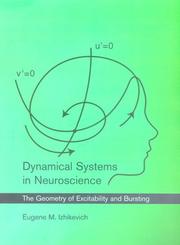| Listing 1 - 1 of 1 |
Sort by
|

ISBN: 9780262090438 0262090430 0262514206 9786612097898 0262276070 128209789X 1429413050 9780262276078 9781429413053 Year: 2007 Publisher: Cambridge, Mass. MIT Press
Abstract | Keywords | Export | Availability | Bookmark
 Loading...
Loading...Choose an application
- Reference Manager
- EndNote
- RefWorks (Direct export to RefWorks)
Explains the relationship of electrophysiology, nonlinear dynamics, and the computational properties of neurons, with each concept presented in terms of both neuroscience and mathematics and illustrated using geometrical intuition. In order to model neuronal behavior or to interpret the results of modeling studies, neuroscientists must call upon methods of nonlinear dynamics. This book offers an introduction to nonlinear dynamical systems theory for researchers and graduate students in neuroscience. It also provides an overview of neuroscience for mathematicians who want to learn the basic facts of electrophysiology. Dynamical Systems in Neuroscience presents a systematic study of the relationship of electrophysiology, nonlinear dynamics, and computational properties of neurons. It emphasizes that information processing in the brain depends not only on the electrophysiological properties of neurons but also on their dynamical properties. The book introduces dynamical systems, starting with one- and two-dimensional Hodgkin-Huxley-type models and continuing to a description of bursting systems. Each chapter proceeds from the simple to the complex, and provides sample problems at the end. The book explains all necessary mathematical concepts using geometrical intuition; it includes many figures and few equations, making it especially suitable for non-mathematicians. Each concept is presented in terms of both neuroscience and mathematics, providing a link between the two disciplines. Nonlinear dynamical systems theory is at the core of computational neuroscience research, but it is not a standard part of the graduate neuroscience curriculum--or taught by math or physics department in a way that is suitable for students of biology. This book offers neuroscience students and researchers a comprehensive account of concepts and methods increasingly used in computational neuroscience. An additional chapter on synchronization, with more advanced material, can be found at the author's website, www.izhikevich.com.
Differentiable dynamical systems. --- Neurology. --- Neurons. --- Neurosciences. --- Models, Neurological --- Neurons --- Neurosciences --- Models, Neurological. --- Differential dynamical systems --- Dynamical systems, Differentiable --- Dynamics, Differentiable --- Nerve cells --- Neurocytes --- Neural sciences --- Neurological sciences --- Neuroscience --- Differential equations --- Global analysis (Mathematics) --- Topological dynamics --- Cells --- Nervous system --- Medicine --- Neuropsychiatry --- Medical sciences --- Diseases --- Differentiable dynamical systems --- Neurology --- NEUROSCIENCE/General --- Neurologia --- Electrofisiologia --- Sistemes dinàmics diferenciables --- Electricitat animal --- Electrobiologia --- Fisiologia --- Anestèsia elèctrica --- Circuit neuronal --- Electrocardiografia --- Electroencefalografia --- Músculs --- Potencials evocats (Electrofisiologia) --- Medicina --- Inhibició --- Neurocirurgia --- Neurooftalmologia --- Neuroimmunologia --- Neurologia pediàtrica --- Neurologia geriàtrica --- Neurologia veterinària --- Psicofisiologia --- Psicopatologia --- Urgències en neurologia --- Neuròlegs --- Dinàmica diferencial --- Exponents de Lyapunov --- Fluxos (Sistemes dinàmics diferenciables) --- Sistemes dinàmics aleatoris --- Sistemes dinàmics complexos --- Sistemes dinàmics hiperbòlics --- Sistemes hamiltonians --- Teoria de la bifurcació --- Dinàmica topològica --- Dinàmica combinatòria
| Listing 1 - 1 of 1 |
Sort by
|

 Search
Search Feedback
Feedback About
About Help
Help News
News